Strategies for Ethical Communication in Business Teams
VerifiedAdded on 2020/05/04
|9
|2719
|50
Essay
AI Summary
This essay delves into the importance of ethical communication in a business context, focusing on strategies to enhance teamwork and organizational performance. It examines how effective communication fosters robust relationships among team members, leading to improved productivity and the achievement of common goals. The essay discusses the impact of ethical communication on team dynamics, highlighting elements that affect communication in the workplace and the role of ethics in promoting a productive work environment. It references various studies to support its arguments, emphasizing that ethical communication is crucial for building strong teams, mitigating conflicts, and ensuring that employees understand their responsibilities. The essay concludes by summarizing how ethical communication, teamwork, and organizational ethics are interconnected and contribute to a successful business environment. The essay also discusses the role of ethical behavior and communication in the workplace.
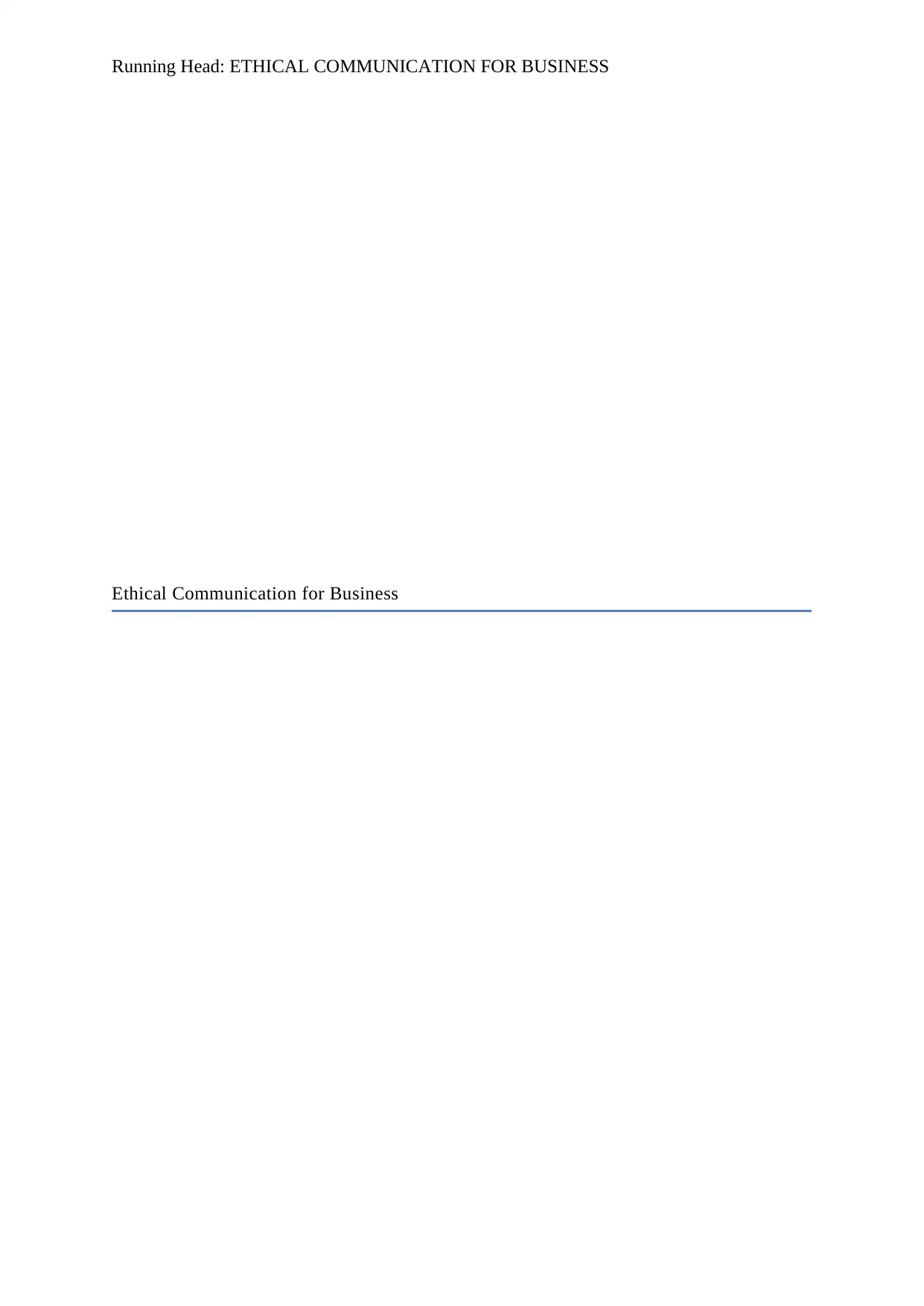
Running Head: ETHICAL COMMUNICATION FOR BUSINESS
Ethical Communication for Business
Ethical Communication for Business
Paraphrase This Document
Need a fresh take? Get an instant paraphrase of this document with our AI Paraphraser
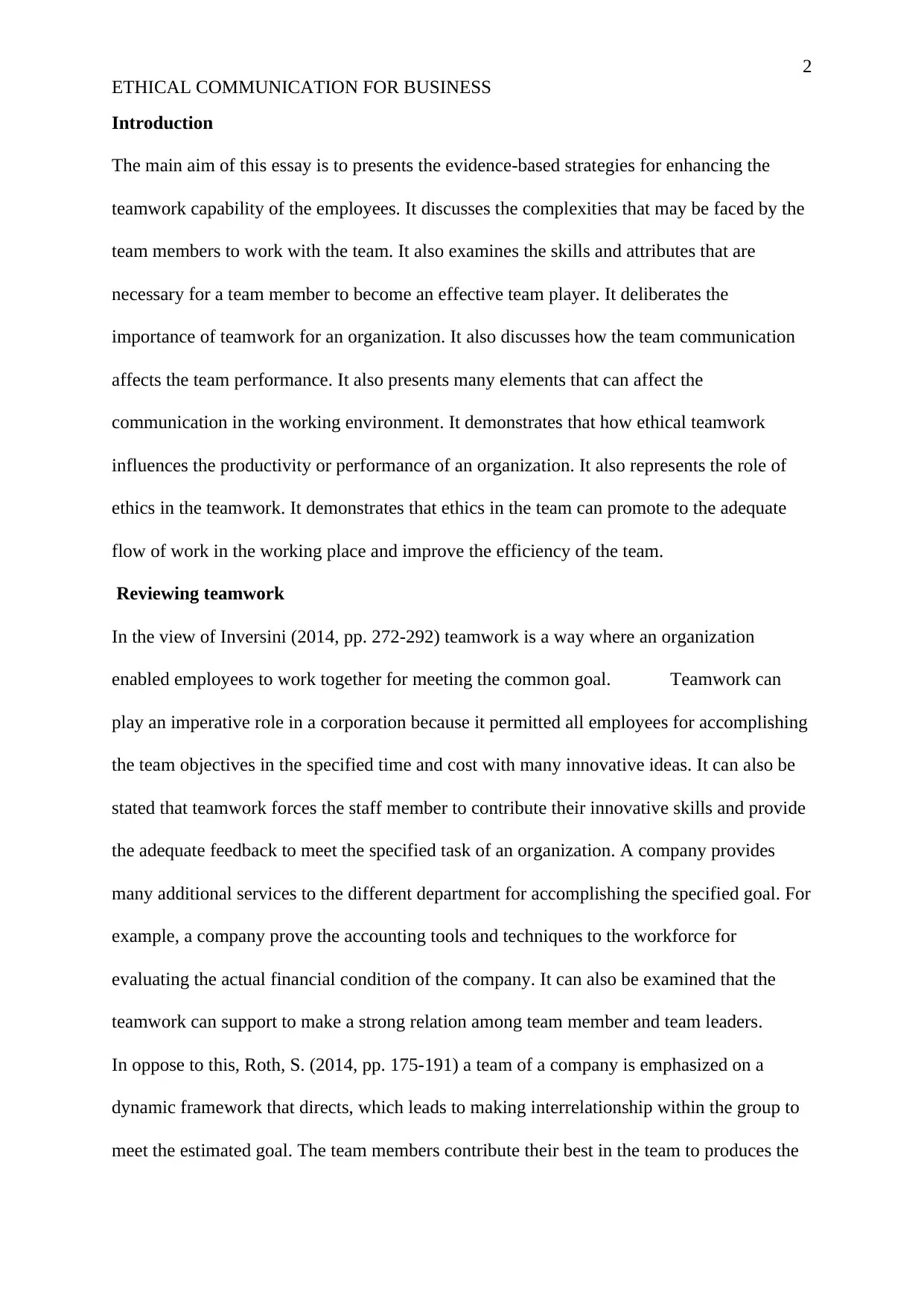
2
ETHICAL COMMUNICATION FOR BUSINESS
Introduction
The main aim of this essay is to presents the evidence-based strategies for enhancing the
teamwork capability of the employees. It discusses the complexities that may be faced by the
team members to work with the team. It also examines the skills and attributes that are
necessary for a team member to become an effective team player. It deliberates the
importance of teamwork for an organization. It also discusses how the team communication
affects the team performance. It also presents many elements that can affect the
communication in the working environment. It demonstrates that how ethical teamwork
influences the productivity or performance of an organization. It also represents the role of
ethics in the teamwork. It demonstrates that ethics in the team can promote to the adequate
flow of work in the working place and improve the efficiency of the team.
Reviewing teamwork
In the view of Inversini (2014, pp. 272-292) teamwork is a way where an organization
enabled employees to work together for meeting the common goal. Teamwork can
play an imperative role in a corporation because it permitted all employees for accomplishing
the team objectives in the specified time and cost with many innovative ideas. It can also be
stated that teamwork forces the staff member to contribute their innovative skills and provide
the adequate feedback to meet the specified task of an organization. A company provides
many additional services to the different department for accomplishing the specified goal. For
example, a company prove the accounting tools and techniques to the workforce for
evaluating the actual financial condition of the company. It can also be examined that the
teamwork can support to make a strong relation among team member and team leaders.
In oppose to this, Roth, S. (2014, pp. 175-191) a team of a company is emphasized on a
dynamic framework that directs, which leads to making interrelationship within the group to
meet the estimated goal. The team members contribute their best in the team to produces the
ETHICAL COMMUNICATION FOR BUSINESS
Introduction
The main aim of this essay is to presents the evidence-based strategies for enhancing the
teamwork capability of the employees. It discusses the complexities that may be faced by the
team members to work with the team. It also examines the skills and attributes that are
necessary for a team member to become an effective team player. It deliberates the
importance of teamwork for an organization. It also discusses how the team communication
affects the team performance. It also presents many elements that can affect the
communication in the working environment. It demonstrates that how ethical teamwork
influences the productivity or performance of an organization. It also represents the role of
ethics in the teamwork. It demonstrates that ethics in the team can promote to the adequate
flow of work in the working place and improve the efficiency of the team.
Reviewing teamwork
In the view of Inversini (2014, pp. 272-292) teamwork is a way where an organization
enabled employees to work together for meeting the common goal. Teamwork can
play an imperative role in a corporation because it permitted all employees for accomplishing
the team objectives in the specified time and cost with many innovative ideas. It can also be
stated that teamwork forces the staff member to contribute their innovative skills and provide
the adequate feedback to meet the specified task of an organization. A company provides
many additional services to the different department for accomplishing the specified goal. For
example, a company prove the accounting tools and techniques to the workforce for
evaluating the actual financial condition of the company. It can also be examined that the
teamwork can support to make a strong relation among team member and team leaders.
In oppose to this, Roth, S. (2014, pp. 175-191) a team of a company is emphasized on a
dynamic framework that directs, which leads to making interrelationship within the group to
meet the estimated goal. The team members contribute their best in the team to produces the
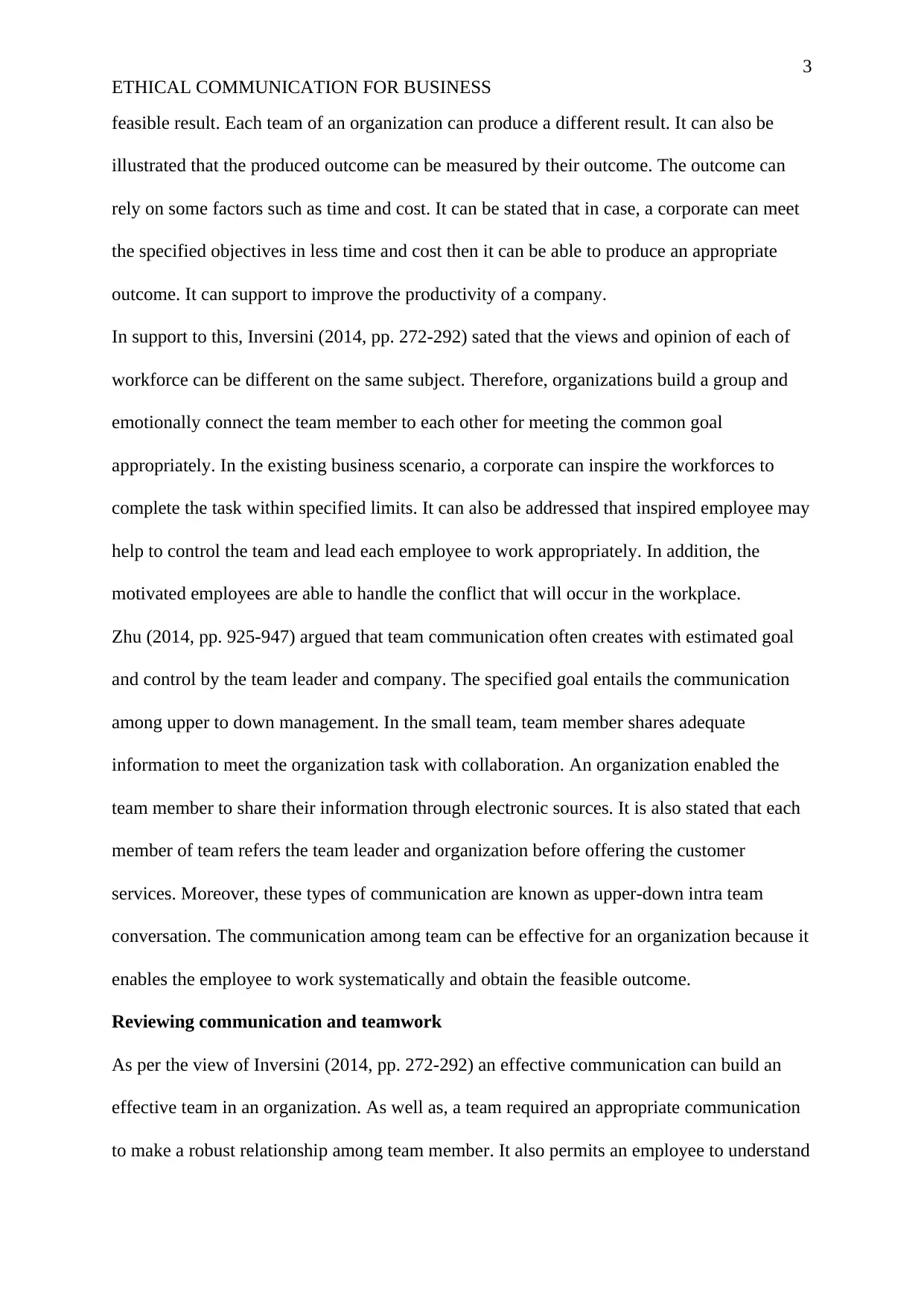
3
ETHICAL COMMUNICATION FOR BUSINESS
feasible result. Each team of an organization can produce a different result. It can also be
illustrated that the produced outcome can be measured by their outcome. The outcome can
rely on some factors such as time and cost. It can be stated that in case, a corporate can meet
the specified objectives in less time and cost then it can be able to produce an appropriate
outcome. It can support to improve the productivity of a company.
In support to this, Inversini (2014, pp. 272-292) sated that the views and opinion of each of
workforce can be different on the same subject. Therefore, organizations build a group and
emotionally connect the team member to each other for meeting the common goal
appropriately. In the existing business scenario, a corporate can inspire the workforces to
complete the task within specified limits. It can also be addressed that inspired employee may
help to control the team and lead each employee to work appropriately. In addition, the
motivated employees are able to handle the conflict that will occur in the workplace.
Zhu (2014, pp. 925-947) argued that team communication often creates with estimated goal
and control by the team leader and company. The specified goal entails the communication
among upper to down management. In the small team, team member shares adequate
information to meet the organization task with collaboration. An organization enabled the
team member to share their information through electronic sources. It is also stated that each
member of team refers the team leader and organization before offering the customer
services. Moreover, these types of communication are known as upper-down intra team
conversation. The communication among team can be effective for an organization because it
enables the employee to work systematically and obtain the feasible outcome.
Reviewing communication and teamwork
As per the view of Inversini (2014, pp. 272-292) an effective communication can build an
effective team in an organization. As well as, a team required an appropriate communication
to make a robust relationship among team member. It also permits an employee to understand
ETHICAL COMMUNICATION FOR BUSINESS
feasible result. Each team of an organization can produce a different result. It can also be
illustrated that the produced outcome can be measured by their outcome. The outcome can
rely on some factors such as time and cost. It can be stated that in case, a corporate can meet
the specified objectives in less time and cost then it can be able to produce an appropriate
outcome. It can support to improve the productivity of a company.
In support to this, Inversini (2014, pp. 272-292) sated that the views and opinion of each of
workforce can be different on the same subject. Therefore, organizations build a group and
emotionally connect the team member to each other for meeting the common goal
appropriately. In the existing business scenario, a corporate can inspire the workforces to
complete the task within specified limits. It can also be addressed that inspired employee may
help to control the team and lead each employee to work appropriately. In addition, the
motivated employees are able to handle the conflict that will occur in the workplace.
Zhu (2014, pp. 925-947) argued that team communication often creates with estimated goal
and control by the team leader and company. The specified goal entails the communication
among upper to down management. In the small team, team member shares adequate
information to meet the organization task with collaboration. An organization enabled the
team member to share their information through electronic sources. It is also stated that each
member of team refers the team leader and organization before offering the customer
services. Moreover, these types of communication are known as upper-down intra team
conversation. The communication among team can be effective for an organization because it
enables the employee to work systematically and obtain the feasible outcome.
Reviewing communication and teamwork
As per the view of Inversini (2014, pp. 272-292) an effective communication can build an
effective team in an organization. As well as, a team required an appropriate communication
to make a robust relationship among team member. It also permits an employee to understand
⊘ This is a preview!⊘
Do you want full access?
Subscribe today to unlock all pages.

Trusted by 1+ million students worldwide
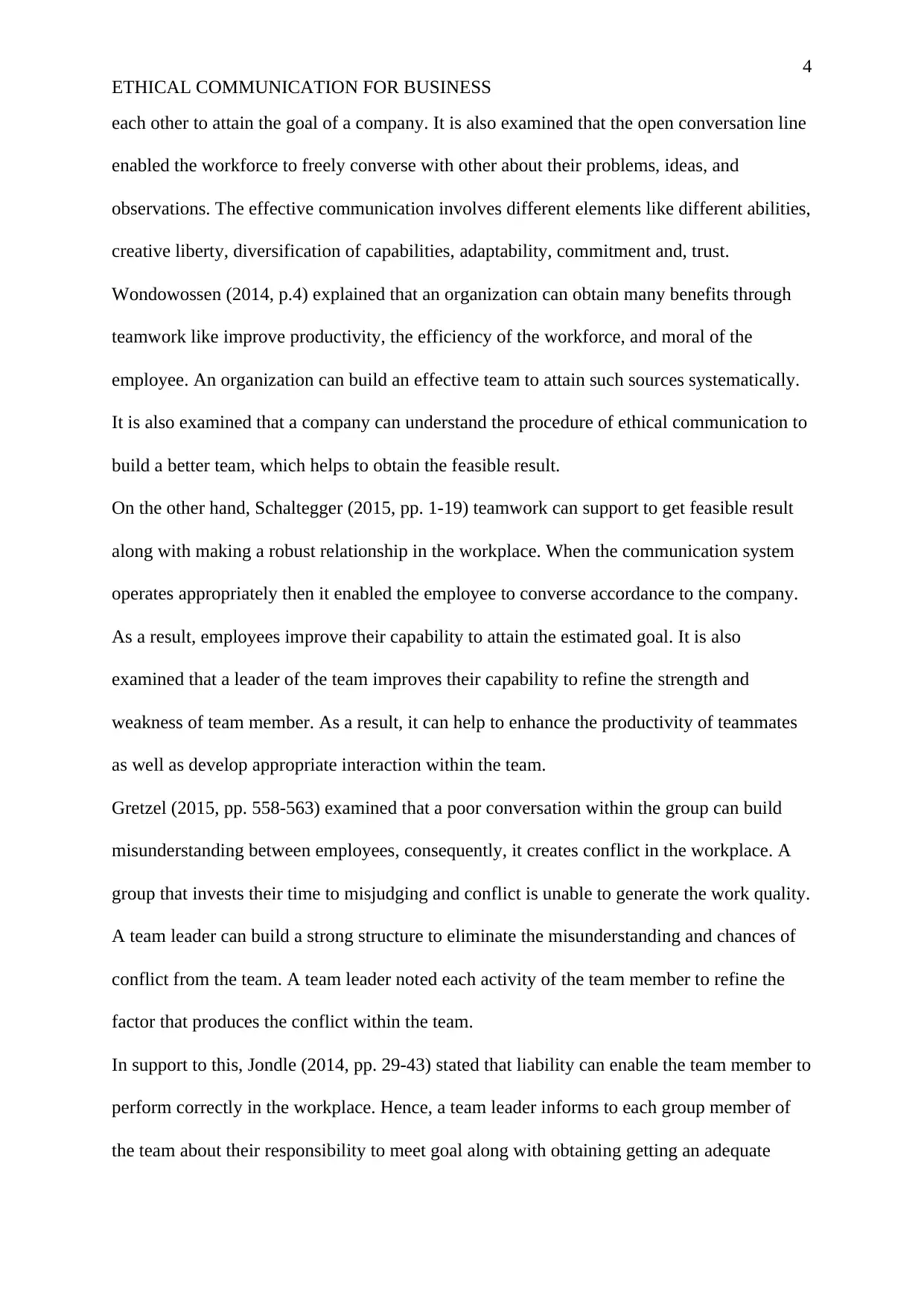
4
ETHICAL COMMUNICATION FOR BUSINESS
each other to attain the goal of a company. It is also examined that the open conversation line
enabled the workforce to freely converse with other about their problems, ideas, and
observations. The effective communication involves different elements like different abilities,
creative liberty, diversification of capabilities, adaptability, commitment and, trust.
Wondowossen (2014, p.4) explained that an organization can obtain many benefits through
teamwork like improve productivity, the efficiency of the workforce, and moral of the
employee. An organization can build an effective team to attain such sources systematically.
It is also examined that a company can understand the procedure of ethical communication to
build a better team, which helps to obtain the feasible result.
On the other hand, Schaltegger (2015, pp. 1-19) teamwork can support to get feasible result
along with making a robust relationship in the workplace. When the communication system
operates appropriately then it enabled the employee to converse accordance to the company.
As a result, employees improve their capability to attain the estimated goal. It is also
examined that a leader of the team improves their capability to refine the strength and
weakness of team member. As a result, it can help to enhance the productivity of teammates
as well as develop appropriate interaction within the team.
Gretzel (2015, pp. 558-563) examined that a poor conversation within the group can build
misunderstanding between employees, consequently, it creates conflict in the workplace. A
group that invests their time to misjudging and conflict is unable to generate the work quality.
A team leader can build a strong structure to eliminate the misunderstanding and chances of
conflict from the team. A team leader noted each activity of the team member to refine the
factor that produces the conflict within the team.
In support to this, Jondle (2014, pp. 29-43) stated that liability can enable the team member to
perform correctly in the workplace. Hence, a team leader informs to each group member of
the team about their responsibility to meet goal along with obtaining getting an adequate
ETHICAL COMMUNICATION FOR BUSINESS
each other to attain the goal of a company. It is also examined that the open conversation line
enabled the workforce to freely converse with other about their problems, ideas, and
observations. The effective communication involves different elements like different abilities,
creative liberty, diversification of capabilities, adaptability, commitment and, trust.
Wondowossen (2014, p.4) explained that an organization can obtain many benefits through
teamwork like improve productivity, the efficiency of the workforce, and moral of the
employee. An organization can build an effective team to attain such sources systematically.
It is also examined that a company can understand the procedure of ethical communication to
build a better team, which helps to obtain the feasible result.
On the other hand, Schaltegger (2015, pp. 1-19) teamwork can support to get feasible result
along with making a robust relationship in the workplace. When the communication system
operates appropriately then it enabled the employee to converse accordance to the company.
As a result, employees improve their capability to attain the estimated goal. It is also
examined that a leader of the team improves their capability to refine the strength and
weakness of team member. As a result, it can help to enhance the productivity of teammates
as well as develop appropriate interaction within the team.
Gretzel (2015, pp. 558-563) examined that a poor conversation within the group can build
misunderstanding between employees, consequently, it creates conflict in the workplace. A
group that invests their time to misjudging and conflict is unable to generate the work quality.
A team leader can build a strong structure to eliminate the misunderstanding and chances of
conflict from the team. A team leader noted each activity of the team member to refine the
factor that produces the conflict within the team.
In support to this, Jondle (2014, pp. 29-43) stated that liability can enable the team member to
perform correctly in the workplace. Hence, a team leader informs to each group member of
the team about their responsibility to meet goal along with obtaining getting an adequate
Paraphrase This Document
Need a fresh take? Get an instant paraphrase of this document with our AI Paraphraser
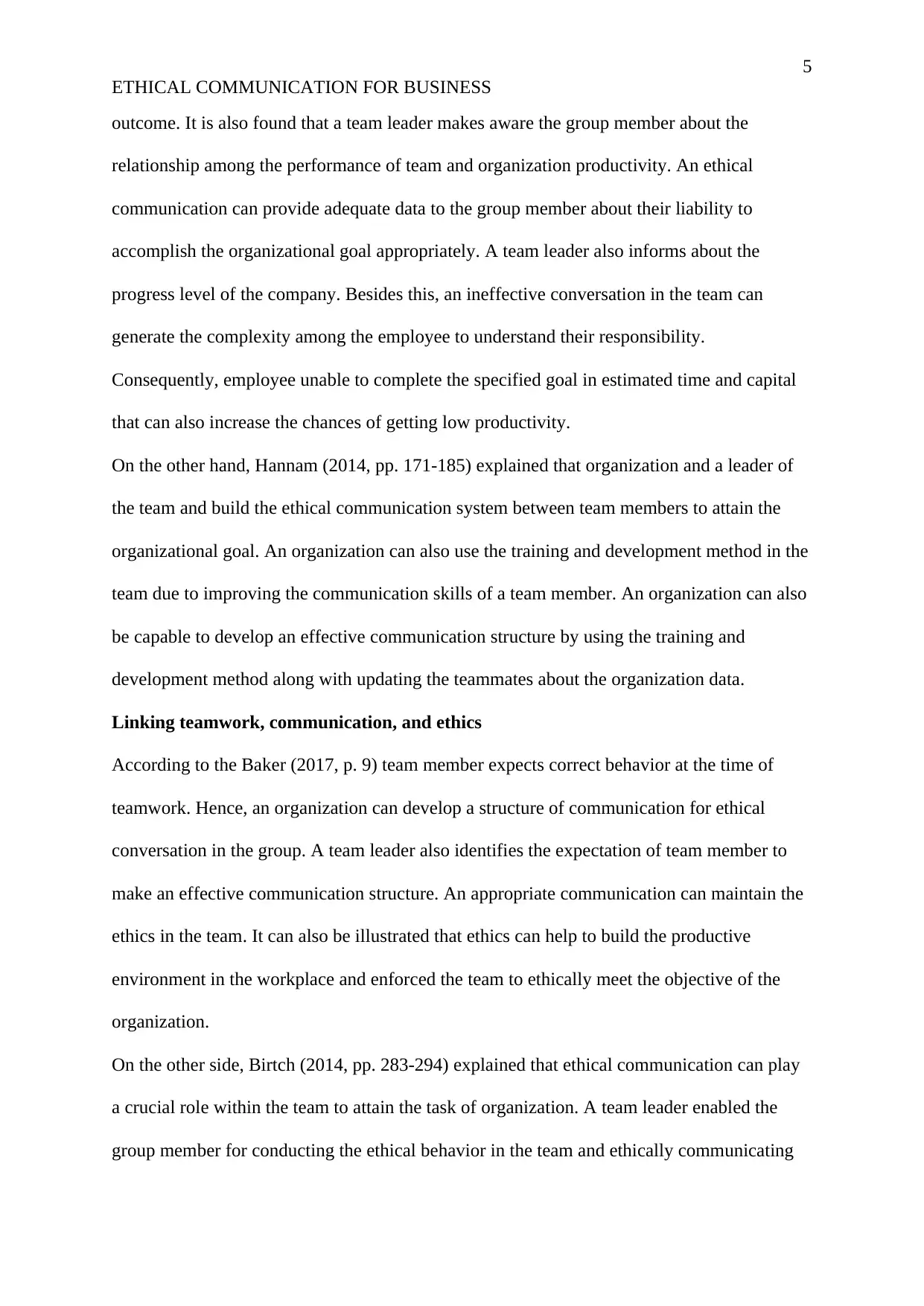
5
ETHICAL COMMUNICATION FOR BUSINESS
outcome. It is also found that a team leader makes aware the group member about the
relationship among the performance of team and organization productivity. An ethical
communication can provide adequate data to the group member about their liability to
accomplish the organizational goal appropriately. A team leader also informs about the
progress level of the company. Besides this, an ineffective conversation in the team can
generate the complexity among the employee to understand their responsibility.
Consequently, employee unable to complete the specified goal in estimated time and capital
that can also increase the chances of getting low productivity.
On the other hand, Hannam (2014, pp. 171-185) explained that organization and a leader of
the team and build the ethical communication system between team members to attain the
organizational goal. An organization can also use the training and development method in the
team due to improving the communication skills of a team member. An organization can also
be capable to develop an effective communication structure by using the training and
development method along with updating the teammates about the organization data.
Linking teamwork, communication, and ethics
According to the Baker (2017, p. 9) team member expects correct behavior at the time of
teamwork. Hence, an organization can develop a structure of communication for ethical
conversation in the group. A team leader also identifies the expectation of team member to
make an effective communication structure. An appropriate communication can maintain the
ethics in the team. It can also be illustrated that ethics can help to build the productive
environment in the workplace and enforced the team to ethically meet the objective of the
organization.
On the other side, Birtch (2014, pp. 283-294) explained that ethical communication can play
a crucial role within the team to attain the task of organization. A team leader enabled the
group member for conducting the ethical behavior in the team and ethically communicating
ETHICAL COMMUNICATION FOR BUSINESS
outcome. It is also found that a team leader makes aware the group member about the
relationship among the performance of team and organization productivity. An ethical
communication can provide adequate data to the group member about their liability to
accomplish the organizational goal appropriately. A team leader also informs about the
progress level of the company. Besides this, an ineffective conversation in the team can
generate the complexity among the employee to understand their responsibility.
Consequently, employee unable to complete the specified goal in estimated time and capital
that can also increase the chances of getting low productivity.
On the other hand, Hannam (2014, pp. 171-185) explained that organization and a leader of
the team and build the ethical communication system between team members to attain the
organizational goal. An organization can also use the training and development method in the
team due to improving the communication skills of a team member. An organization can also
be capable to develop an effective communication structure by using the training and
development method along with updating the teammates about the organization data.
Linking teamwork, communication, and ethics
According to the Baker (2017, p. 9) team member expects correct behavior at the time of
teamwork. Hence, an organization can develop a structure of communication for ethical
conversation in the group. A team leader also identifies the expectation of team member to
make an effective communication structure. An appropriate communication can maintain the
ethics in the team. It can also be illustrated that ethics can help to build the productive
environment in the workplace and enforced the team to ethically meet the objective of the
organization.
On the other side, Birtch (2014, pp. 283-294) explained that ethical communication can play
a crucial role within the team to attain the task of organization. A team leader enabled the
group member for conducting the ethical behavior in the team and ethically communicating
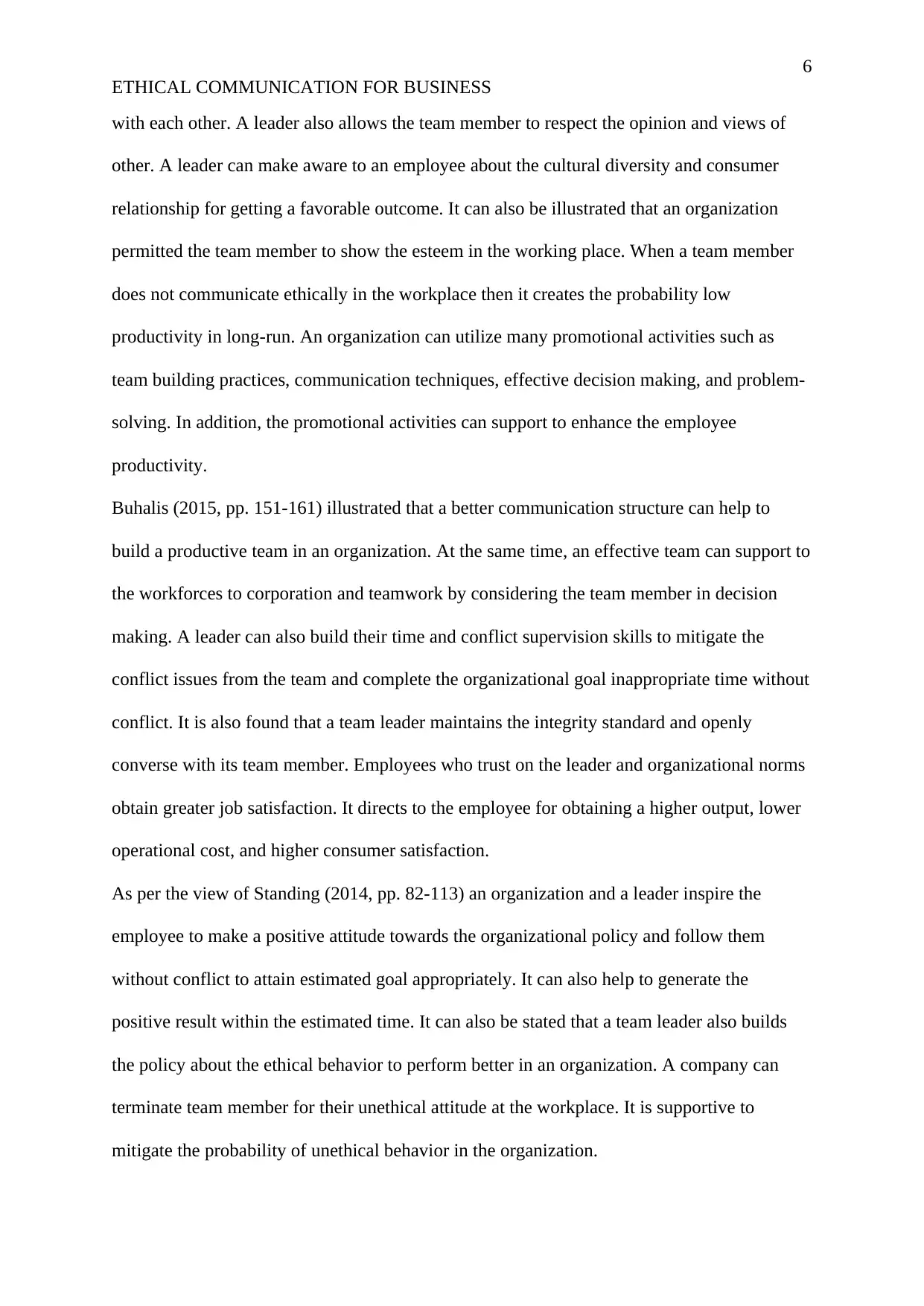
6
ETHICAL COMMUNICATION FOR BUSINESS
with each other. A leader also allows the team member to respect the opinion and views of
other. A leader can make aware to an employee about the cultural diversity and consumer
relationship for getting a favorable outcome. It can also be illustrated that an organization
permitted the team member to show the esteem in the working place. When a team member
does not communicate ethically in the workplace then it creates the probability low
productivity in long-run. An organization can utilize many promotional activities such as
team building practices, communication techniques, effective decision making, and problem-
solving. In addition, the promotional activities can support to enhance the employee
productivity.
Buhalis (2015, pp. 151-161) illustrated that a better communication structure can help to
build a productive team in an organization. At the same time, an effective team can support to
the workforces to corporation and teamwork by considering the team member in decision
making. A leader can also build their time and conflict supervision skills to mitigate the
conflict issues from the team and complete the organizational goal inappropriate time without
conflict. It is also found that a team leader maintains the integrity standard and openly
converse with its team member. Employees who trust on the leader and organizational norms
obtain greater job satisfaction. It directs to the employee for obtaining a higher output, lower
operational cost, and higher consumer satisfaction.
As per the view of Standing (2014, pp. 82-113) an organization and a leader inspire the
employee to make a positive attitude towards the organizational policy and follow them
without conflict to attain estimated goal appropriately. It can also help to generate the
positive result within the estimated time. It can also be stated that a team leader also builds
the policy about the ethical behavior to perform better in an organization. A company can
terminate team member for their unethical attitude at the workplace. It is supportive to
mitigate the probability of unethical behavior in the organization.
ETHICAL COMMUNICATION FOR BUSINESS
with each other. A leader also allows the team member to respect the opinion and views of
other. A leader can make aware to an employee about the cultural diversity and consumer
relationship for getting a favorable outcome. It can also be illustrated that an organization
permitted the team member to show the esteem in the working place. When a team member
does not communicate ethically in the workplace then it creates the probability low
productivity in long-run. An organization can utilize many promotional activities such as
team building practices, communication techniques, effective decision making, and problem-
solving. In addition, the promotional activities can support to enhance the employee
productivity.
Buhalis (2015, pp. 151-161) illustrated that a better communication structure can help to
build a productive team in an organization. At the same time, an effective team can support to
the workforces to corporation and teamwork by considering the team member in decision
making. A leader can also build their time and conflict supervision skills to mitigate the
conflict issues from the team and complete the organizational goal inappropriate time without
conflict. It is also found that a team leader maintains the integrity standard and openly
converse with its team member. Employees who trust on the leader and organizational norms
obtain greater job satisfaction. It directs to the employee for obtaining a higher output, lower
operational cost, and higher consumer satisfaction.
As per the view of Standing (2014, pp. 82-113) an organization and a leader inspire the
employee to make a positive attitude towards the organizational policy and follow them
without conflict to attain estimated goal appropriately. It can also help to generate the
positive result within the estimated time. It can also be stated that a team leader also builds
the policy about the ethical behavior to perform better in an organization. A company can
terminate team member for their unethical attitude at the workplace. It is supportive to
mitigate the probability of unethical behavior in the organization.
⊘ This is a preview!⊘
Do you want full access?
Subscribe today to unlock all pages.

Trusted by 1+ million students worldwide
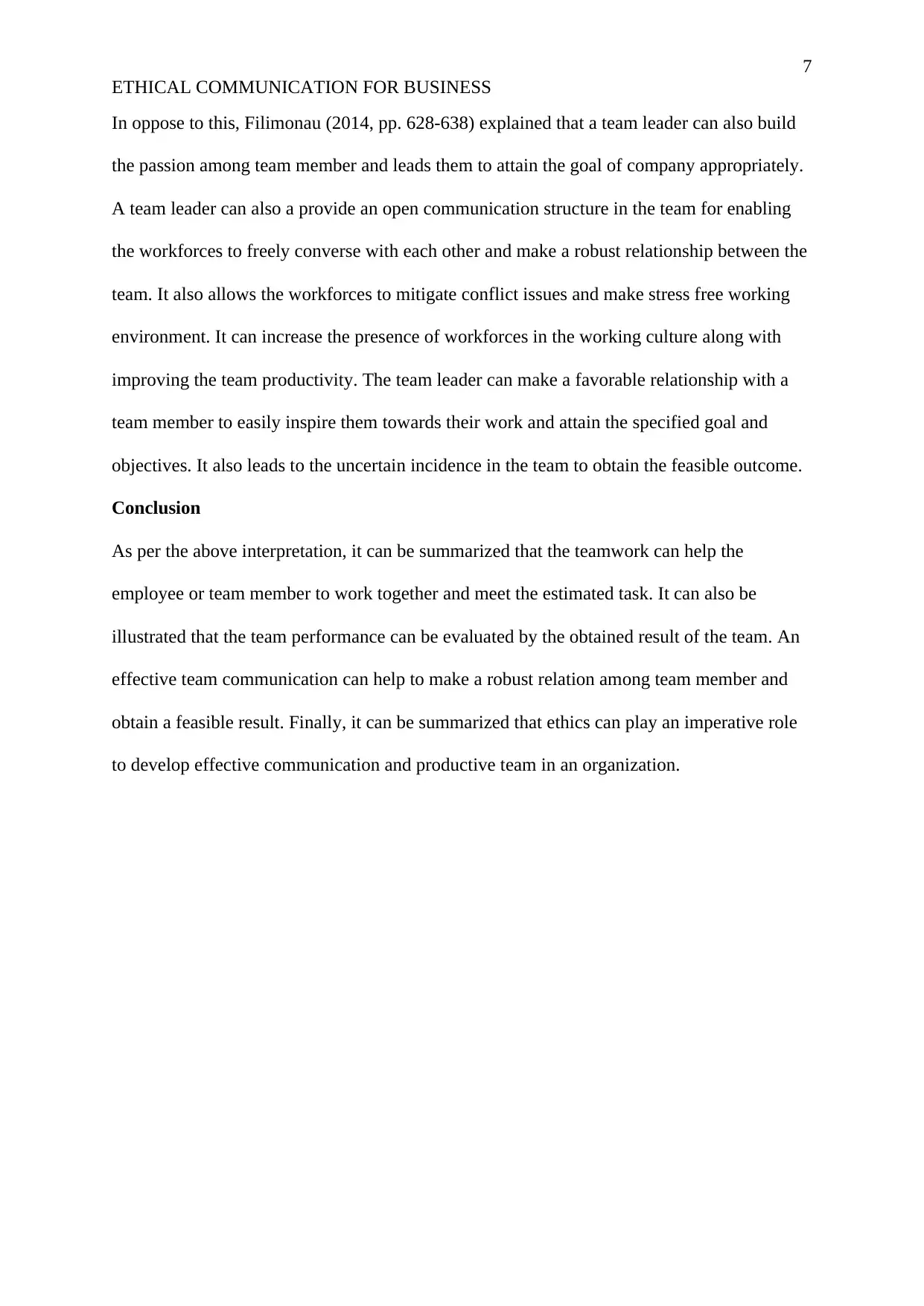
7
ETHICAL COMMUNICATION FOR BUSINESS
In oppose to this, Filimonau (2014, pp. 628-638) explained that a team leader can also build
the passion among team member and leads them to attain the goal of company appropriately.
A team leader can also a provide an open communication structure in the team for enabling
the workforces to freely converse with each other and make a robust relationship between the
team. It also allows the workforces to mitigate conflict issues and make stress free working
environment. It can increase the presence of workforces in the working culture along with
improving the team productivity. The team leader can make a favorable relationship with a
team member to easily inspire them towards their work and attain the specified goal and
objectives. It also leads to the uncertain incidence in the team to obtain the feasible outcome.
Conclusion
As per the above interpretation, it can be summarized that the teamwork can help the
employee or team member to work together and meet the estimated task. It can also be
illustrated that the team performance can be evaluated by the obtained result of the team. An
effective team communication can help to make a robust relation among team member and
obtain a feasible result. Finally, it can be summarized that ethics can play an imperative role
to develop effective communication and productive team in an organization.
ETHICAL COMMUNICATION FOR BUSINESS
In oppose to this, Filimonau (2014, pp. 628-638) explained that a team leader can also build
the passion among team member and leads them to attain the goal of company appropriately.
A team leader can also a provide an open communication structure in the team for enabling
the workforces to freely converse with each other and make a robust relationship between the
team. It also allows the workforces to mitigate conflict issues and make stress free working
environment. It can increase the presence of workforces in the working culture along with
improving the team productivity. The team leader can make a favorable relationship with a
team member to easily inspire them towards their work and attain the specified goal and
objectives. It also leads to the uncertain incidence in the team to obtain the feasible outcome.
Conclusion
As per the above interpretation, it can be summarized that the teamwork can help the
employee or team member to work together and meet the estimated task. It can also be
illustrated that the team performance can be evaluated by the obtained result of the team. An
effective team communication can help to make a robust relation among team member and
obtain a feasible result. Finally, it can be summarized that ethics can play an imperative role
to develop effective communication and productive team in an organization.
Paraphrase This Document
Need a fresh take? Get an instant paraphrase of this document with our AI Paraphraser
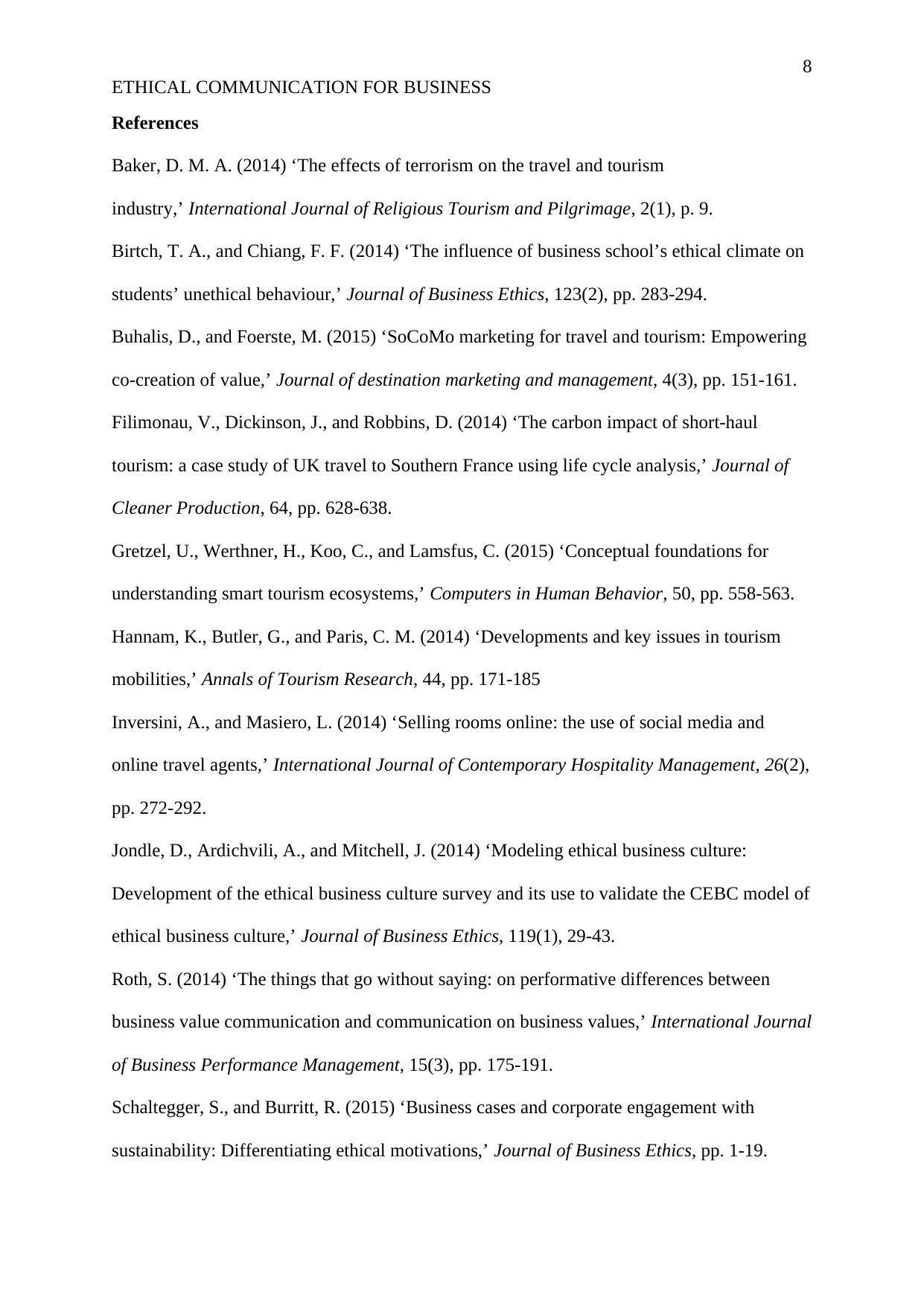
8
ETHICAL COMMUNICATION FOR BUSINESS
References
Baker, D. M. A. (2014) ‘The effects of terrorism on the travel and tourism
industry,’ International Journal of Religious Tourism and Pilgrimage, 2(1), p. 9.
Birtch, T. A., and Chiang, F. F. (2014) ‘The influence of business school’s ethical climate on
students’ unethical behaviour,’ Journal of Business Ethics, 123(2), pp. 283-294.
Buhalis, D., and Foerste, M. (2015) ‘SoCoMo marketing for travel and tourism: Empowering
co-creation of value,’ Journal of destination marketing and management, 4(3), pp. 151-161.
Filimonau, V., Dickinson, J., and Robbins, D. (2014) ‘The carbon impact of short-haul
tourism: a case study of UK travel to Southern France using life cycle analysis,’ Journal of
Cleaner Production, 64, pp. 628-638.
Gretzel, U., Werthner, H., Koo, C., and Lamsfus, C. (2015) ‘Conceptual foundations for
understanding smart tourism ecosystems,’ Computers in Human Behavior, 50, pp. 558-563.
Hannam, K., Butler, G., and Paris, C. M. (2014) ‘Developments and key issues in tourism
mobilities,’ Annals of Tourism Research, 44, pp. 171-185
Inversini, A., and Masiero, L. (2014) ‘Selling rooms online: the use of social media and
online travel agents,’ International Journal of Contemporary Hospitality Management, 26(2),
pp. 272-292.
Jondle, D., Ardichvili, A., and Mitchell, J. (2014) ‘Modeling ethical business culture:
Development of the ethical business culture survey and its use to validate the CEBC model of
ethical business culture,’ Journal of Business Ethics, 119(1), 29-43.
Roth, S. (2014) ‘The things that go without saying: on performative differences between
business value communication and communication on business values,’ International Journal
of Business Performance Management, 15(3), pp. 175-191.
Schaltegger, S., and Burritt, R. (2015) ‘Business cases and corporate engagement with
sustainability: Differentiating ethical motivations,’ Journal of Business Ethics, pp. 1-19.
ETHICAL COMMUNICATION FOR BUSINESS
References
Baker, D. M. A. (2014) ‘The effects of terrorism on the travel and tourism
industry,’ International Journal of Religious Tourism and Pilgrimage, 2(1), p. 9.
Birtch, T. A., and Chiang, F. F. (2014) ‘The influence of business school’s ethical climate on
students’ unethical behaviour,’ Journal of Business Ethics, 123(2), pp. 283-294.
Buhalis, D., and Foerste, M. (2015) ‘SoCoMo marketing for travel and tourism: Empowering
co-creation of value,’ Journal of destination marketing and management, 4(3), pp. 151-161.
Filimonau, V., Dickinson, J., and Robbins, D. (2014) ‘The carbon impact of short-haul
tourism: a case study of UK travel to Southern France using life cycle analysis,’ Journal of
Cleaner Production, 64, pp. 628-638.
Gretzel, U., Werthner, H., Koo, C., and Lamsfus, C. (2015) ‘Conceptual foundations for
understanding smart tourism ecosystems,’ Computers in Human Behavior, 50, pp. 558-563.
Hannam, K., Butler, G., and Paris, C. M. (2014) ‘Developments and key issues in tourism
mobilities,’ Annals of Tourism Research, 44, pp. 171-185
Inversini, A., and Masiero, L. (2014) ‘Selling rooms online: the use of social media and
online travel agents,’ International Journal of Contemporary Hospitality Management, 26(2),
pp. 272-292.
Jondle, D., Ardichvili, A., and Mitchell, J. (2014) ‘Modeling ethical business culture:
Development of the ethical business culture survey and its use to validate the CEBC model of
ethical business culture,’ Journal of Business Ethics, 119(1), 29-43.
Roth, S. (2014) ‘The things that go without saying: on performative differences between
business value communication and communication on business values,’ International Journal
of Business Performance Management, 15(3), pp. 175-191.
Schaltegger, S., and Burritt, R. (2015) ‘Business cases and corporate engagement with
sustainability: Differentiating ethical motivations,’ Journal of Business Ethics, pp. 1-19.
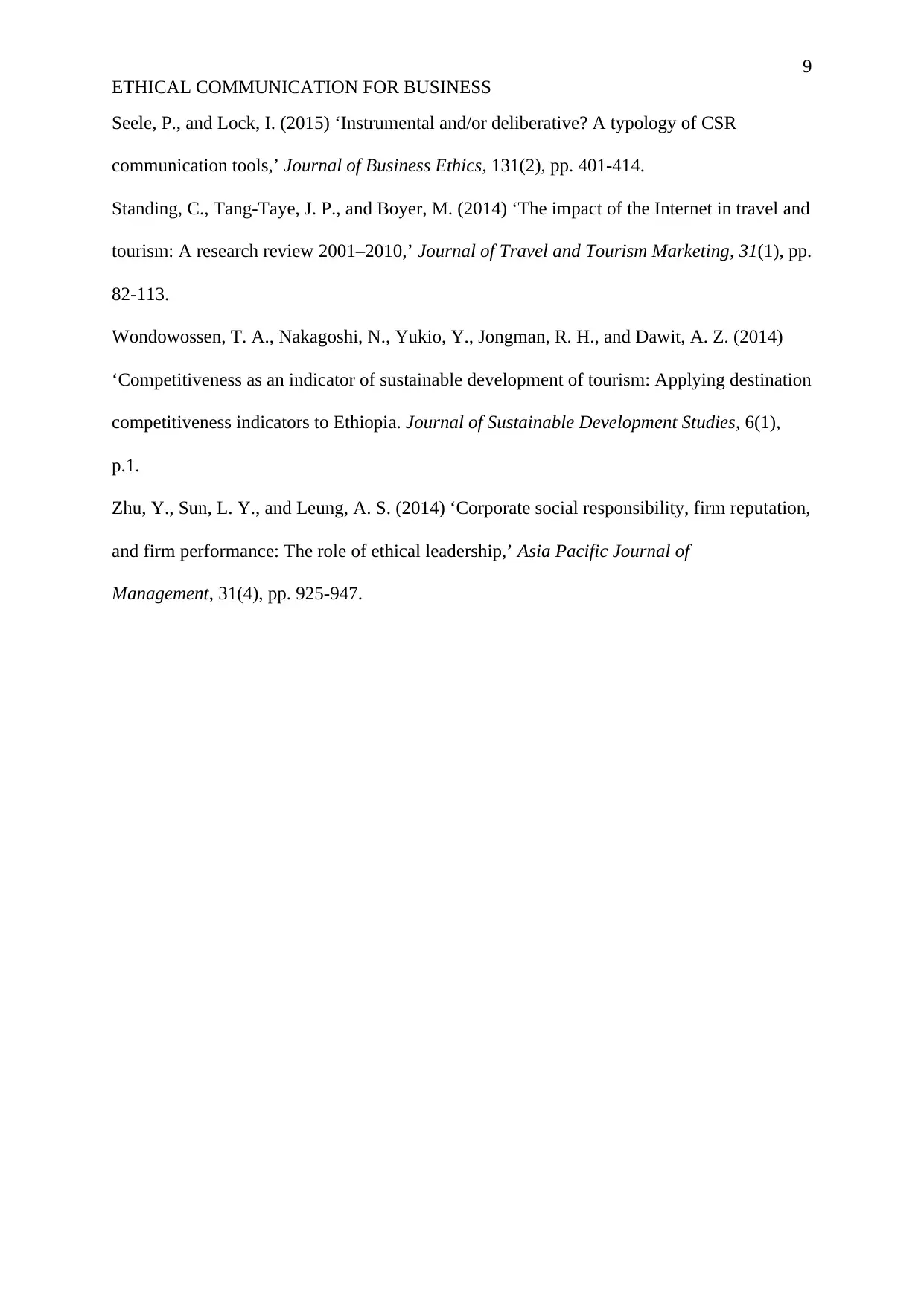
9
ETHICAL COMMUNICATION FOR BUSINESS
Seele, P., and Lock, I. (2015) ‘Instrumental and/or deliberative? A typology of CSR
communication tools,’ Journal of Business Ethics, 131(2), pp. 401-414.
Standing, C., Tang-Taye, J. P., and Boyer, M. (2014) ‘The impact of the Internet in travel and
tourism: A research review 2001–2010,’ Journal of Travel and Tourism Marketing, 31(1), pp.
82-113.
Wondowossen, T. A., Nakagoshi, N., Yukio, Y., Jongman, R. H., and Dawit, A. Z. (2014)
‘Competitiveness as an indicator of sustainable development of tourism: Applying destination
competitiveness indicators to Ethiopia. Journal of Sustainable Development Studies, 6(1),
p.1.
Zhu, Y., Sun, L. Y., and Leung, A. S. (2014) ‘Corporate social responsibility, firm reputation,
and firm performance: The role of ethical leadership,’ Asia Pacific Journal of
Management, 31(4), pp. 925-947.
ETHICAL COMMUNICATION FOR BUSINESS
Seele, P., and Lock, I. (2015) ‘Instrumental and/or deliberative? A typology of CSR
communication tools,’ Journal of Business Ethics, 131(2), pp. 401-414.
Standing, C., Tang-Taye, J. P., and Boyer, M. (2014) ‘The impact of the Internet in travel and
tourism: A research review 2001–2010,’ Journal of Travel and Tourism Marketing, 31(1), pp.
82-113.
Wondowossen, T. A., Nakagoshi, N., Yukio, Y., Jongman, R. H., and Dawit, A. Z. (2014)
‘Competitiveness as an indicator of sustainable development of tourism: Applying destination
competitiveness indicators to Ethiopia. Journal of Sustainable Development Studies, 6(1),
p.1.
Zhu, Y., Sun, L. Y., and Leung, A. S. (2014) ‘Corporate social responsibility, firm reputation,
and firm performance: The role of ethical leadership,’ Asia Pacific Journal of
Management, 31(4), pp. 925-947.
⊘ This is a preview!⊘
Do you want full access?
Subscribe today to unlock all pages.

Trusted by 1+ million students worldwide
1 out of 9
Related Documents
Your All-in-One AI-Powered Toolkit for Academic Success.
+13062052269
info@desklib.com
Available 24*7 on WhatsApp / Email
![[object Object]](/_next/static/media/star-bottom.7253800d.svg)
Unlock your academic potential
Copyright © 2020–2025 A2Z Services. All Rights Reserved. Developed and managed by ZUCOL.





